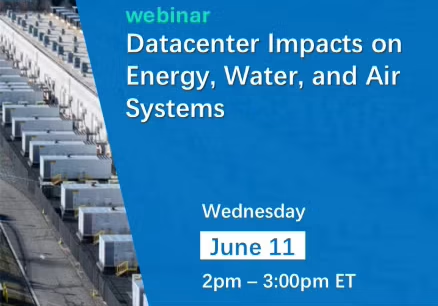
On Wednesday June 11, the National League of Cities (NLC) and the American Association for the Advancement of Science’s Center for Scientific Evidence in Public Issues (AAAS EPI Center) co-hosted a webinar entitled “Datacenter Impacts on Municipal Energy, Water, and Air Systems” as part of their ongoing series on the social, political, and environmental impact of data centers. ESAL founder Arti Garg moderated a discussion with Shaolei Ren, associate professor at the University of California, Riverside which explored the impacts data centers have on energy and water usage, pollution, and human health in the current landscape of increasing demand for compute power from AI.
Datacenters are essential computational infrastructure
In her introduction, Garg explained that data centers are facilities for housing the equipment necessary to generate large amounts of computing power (compute). In practical terms, these are buildings that house racks of servers and networking equipment used to power the essential functions of computer programs, as well as the power and cooling infrastructure. Traditionally, compute demand was largely created by online services such as email and e-commerce. With the surging demand for AI products, data centers are tasked with handling much larger volumes of compute, resulting in ever-increasing demand for data center infrastructure. During the event, Ren gave a presentation titled “The Hidden Environmental and Public Health Impacts of AI”, which reviewed areas that states and municipalities should consider when deciding to allow the construction or continued operation of data centers.
Data center energy demand could inflate energy costs
Ren cited an estimate from the 2024 United States Data Center Energy Usage Report produced by Berkeley Lab that predicts data centers could comprise 6.7% to 12% of the national electricity demand by 2028. With that increase in demand comes a high demand to build new energy infrastructure, along with a steep price tag for construction and an increase in carbon emissions. Datacenters draw energy from the local grid and, when needed, use diesel backup generators. When additional capacity is needed, this can increase demand for fossil fuel energy sources and may also inflate the power bills of individual consumers.
Water consumption is a major impact of data center operations
In addition to their impact on power consumption, data centers consume water at high rates. The equipment used to produce computing power generates heat which needs to be dissipated to ensure continued functioning. Water evaporation is a common cooling method, that consumes water that does not return to the municipal sewer (consumptive use through evaporation) and creates waste water that is high in mineral and salt content that cannot be reused for other purposes as easily. By contrast, residential water use may draw comparable gallons of water but has a higher proportion of nonconsumptive use. Technology companies such as Apple, Meta, and Microsoft produce water strategy and sustainability reports that address the sustainability implications of their current water use. However, AI demand may increase water consumption by 2-4 times over 2023 levels by 2028, according to projections generated by the Berkeley Lab.
Air pollution and public health are also affected
Data centers contribute to air pollution through use of diesel backup generators and electricity consumption. Diesel consumption, in particular, emits nitrogen oxides, which can form PM2.5s (particulate matter with diameter of 2.5 microns or less) that are associated with risk of high blood pressure, heart disease, and lung cancer. Air pollution does not stay confined to state lines, making the issue difficult to regulate on a local level. Ren published a paper using a modeling tool from the EPA to calculate the health cost of increased energy consumption by AI, predicting a potential public health cost increase of billions of dollars with high data center energy use.
Making a local impact
From the perspective of technology companies, there are important benefits of building data centers close to dense population centers, including reduced networking latency and data transfer costs. Due to the factors discussed above, there are also risks associated with locating data centers near communities, which will need to be balanced. Ren highlighted a story from Uruguay, where community pushback over the water use of a local datacenter caused the company to implement a more efficient, albeit more expensive, cooling system. In many cases in the United States, a major challenge to local engagement around data centers comes from a lack of transparency about how much energy and water these facilities are consuming. The National League of Cities (NLC) highlighted the important role of public utility commissions in the process of data centers site selection, as they can help provide information on how data centers may affect energy use and costs in their areas of service. (You can check out ESAL’s playbook on joining an advisory board or commission here.) NLC also has an AI governance dashboard to help cities and municipalities learn from each other’s policies and track how the policies come into effect. When asked how communities can ensure they are balancing the risks and rewards of having data centers in their areas, Ren urged people to ask about water use and pollution outcomes, stating that dialogue will be important to learn more about the potential impacts.